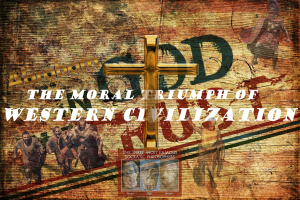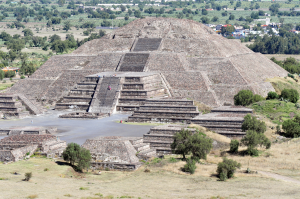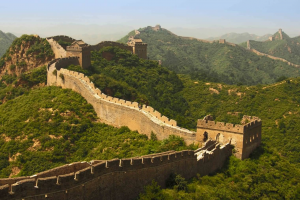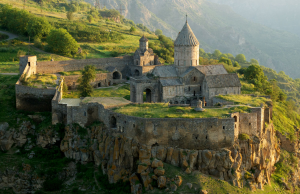 (Part 5 of a multi-part series on The Moral Triumph of Western Civilization.)
(Part 5 of a multi-part series on The Moral Triumph of Western Civilization.)
At the same time the Roman Empire ruled the greater Mediterranean region, in North America the metropolis of Teotihuacan (named much later by the Aztecs) near modern day Mexico City was the largest city in the Western Hemisphere before the 15th century. It is most widely identified by its iconic pyramids: Its Pyramid of the Sun is the third tallest in the world; a wonder at 216′ tall.
The culture lasted for as many as seven centuries but no one knows how it started, how it came to great power and why it collapsed. There are no records. It has no lasting legacy. Even its name: “Teotihuacan” was given by the Aztecs (“City of the Gods”) seven centuries after its collapse so we don’t even know what this thriving culture called itself.1

The Roman era also mostly coincided with the Han dynasty in China but which was likely considerably larger than the 60 million or so under Augustus’ rule at the beginning of the first century. It had begun some amazing achievements as well including the early construction of parts of the Great Wall, the production of silk and iron.
But unlike Teotihuacan, the Han dynasty does have a legacy.
In order to protect its prized “export,” the dynasty closely scrutinized silk production and trade. To accomplish this it produced China’s greatest and longest lasting legacy: a powerful bureaucracy. The dynasty initiated a two-tiered society: one reserved for the provincial enforcers of the emperor and those in their “employ.” It included even reserved lanes on the network of roads solely for official-use-only, i.e., royalty or their enforcers.2

Today, the “people of Han” are what are commonly known as the Chinese. They constitute the largest ethnic group in the world (about 18% if the world’s population). They have consistently embraced the primary legacy of their ancestors: the state’s preeminence over the individual.
The dynasty’s effectiveness at controlling many millions was not dissimilar from the centuries-long iron rule of the Romans. The key difference was the impact of Christianity and its inclusion of individualism on the eventual survivors of Roman rule. Han defined China. Rome did not define Western Civilization. Christianity did.
The “West” at the time of the Roman Empire’s last days included the Mediterranean bordering lands in northern Africa and about the southern half of what we now call the continent of Europe. North of the “Rhine-Danube Corridor” was a frontier inhabited by barbarians. [“Barbarian” is a word of Greek origin essentially meaning ‘incomprehensible speech,’ or being of inferior culture.3 Unpredictable, indiscriminate violence would later characterized these disorganized Germanic tribes.]
From central Asia came wild Turkish groups that ravaged the northern territories, the most famous being the Huns led by Attila who made it all the way to Gaul (France) by the late fifth century. Attila’s advances were eventually stopped by the Romans with considerable assistance from the Germanic Visigoths.
After Rome’s fall, the empire was divided into three distinct regions. One was the Eastern Greek or Byzantine Empire. Its capital was Constantinople (Byzantium renamed by Constantine in 330 A.D.) and it included most of present day Turkey, the Balkans and some parts of Italy. It remained Christian in faith and mostly Greek in culture. At its peak, Constantinople was considered the world’s “preeminent city.”4
The Southern region was eventually dominated by Muslims after the seventh century. Arabic became common language and it remains so today from Morocco to the Persian gulf.
The third region was the least impressive as far as culture and civilization were concerned. It included the areas of (now) France, Belgium, the Rhineland (Germany) and Britain. These regions were made up mostly of small isolated villages not under any central authority.
Most of the western barbarians were German and would later have significant influence on the development of Europe. Some were now Christian but most were heathens.
“Europe” was now a land of various uncivilized, barbaric tribes: Wild Celts in Wales and Scotland, Germans in Europe’s heartland, Persians in the east and Arabs in the southeast. One of the largest tribes, the West Goths, sacked areas around the Mediterranean all the way to Spain. With exception of the Persians, most all were illiterate and very violent.
“Germans” had no written language but did have interesting folklore, were skilled in agriculture and were ferocious fighters. They were very tribal, mostly free and had no sense of state or nation (broad organization). Marauders and tribes, sometimes numbering in the tens of thousands, often captured villages and lived off their agricultural produce. Then, just as suddenly, they would often move on to the next one. Some, however, would settle in these villages, affording protection in return for a share of the produce.
Villages became mostly self-sustaining. Trade was rare given that there was no common currency with demise of the Roman Empire. (When trade did happen, barter ruled.) The West was now isolated, disorganized, and mostly culture-less. It differed little from tribal life on other continents.
While the Romans still occupied Britannia (Britain) they employed some Germanic tribes, which had migrated from the mainland, as paid mercenaries. The primary ones were the Angles and the Saxons.
When the Romans stopped paying these “Anglo-Saxons” (as they would become known much later) mercenaries, and began leaving the island to shore up defenses closer to Rome, the Germanic tribesmen effectively took control of Britannia.
Over time, their numbers grew in England as more of their kin migrated to the island. [The cause of which could be partially attributed to the Medieval Warm Period when Europe’s average temperature was 1oC warmer than today which permitted the growth of crops much farther north. The additional production of food allowed for greater population growth.]
Around the same time the Angles and Saxon were taking over Britain, another Germanic tribe, the Franks, captured Gaul (northern Italy, France, W. Switzerland and Belgium).
In all these regions, there was only one tie to the old “civilized” Greco-Roman era — the Christian church. It remained essentially intact. Most likely as a rebellion against the savagery and killing all around them during the barbaric conquests, religious men developed the institution of the monastery. These became their own isolated communities, safe, violence-free havens in a barbaric world.

Surprisingly, they were mostly left alone by barbarians. The monks were held in deep reverence given their simple, peaceful lives of austerity and contemplation. Gradually, but consistently, the barbarians began to be converted to Christianity.
The Goths began to be converted as early as 340. They translated the Bible into the first recorded German language. Clovis I, leader of the (Germanic) Franks, became Christian in 496. This was “Arian” Christianity or what later became known as Catholicism, aligning themselves with the bishop of Rome (became known as the “Pope” in the 10th century), recognized as the head of the Christian church.
The “king” of Kent in England was converted about a century later. The “Christianization” of the Anglo-Saxons gradually followed. Missionaries from Ireland also, to which Christians of the Roman Empire had fled before the heathen barbarians, now returned to both Britain and the Continent to spread the gospel.”5
By the early 8th century, the amount of territory that had been “Christianized” under the Roman Empire was now about the same as it was before the barbarian onslaught. But not in the Mediterranean bordering areas of Africa. That belonged to a new and highly militaristic religion called Islam.
The descendants of Mohammad vanquished all opposition in the lands of northern Africa, moved into Spain in 711 then attempted to conquer the region of France. They were finally stopped at Tours (France) by the now Christianized Franks led by Charles Martel in 732. Shortly thereafter, Charles’ grandson, would emerge to become a major player in the advancement of Western Civilization.
* * *
1- Lord, Lewis. The Year One. U.S. News and World Report. January 8, 2001. P. 38.
2- ibid.
3- Palmer, R.R. and Colton, Joel. A History of the Modern World. Alfred A. Knopf. New York. 1971.
4- ibid.
5- ibid.

